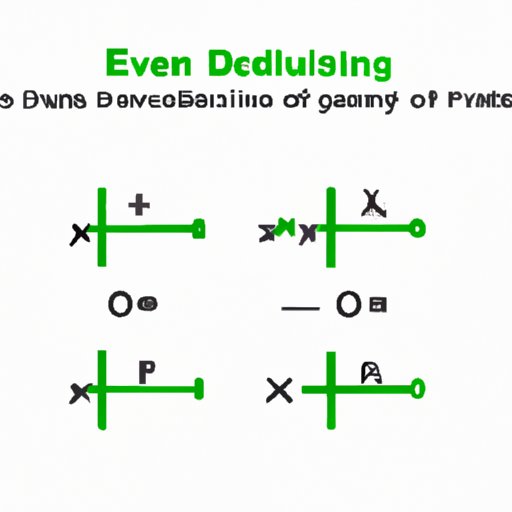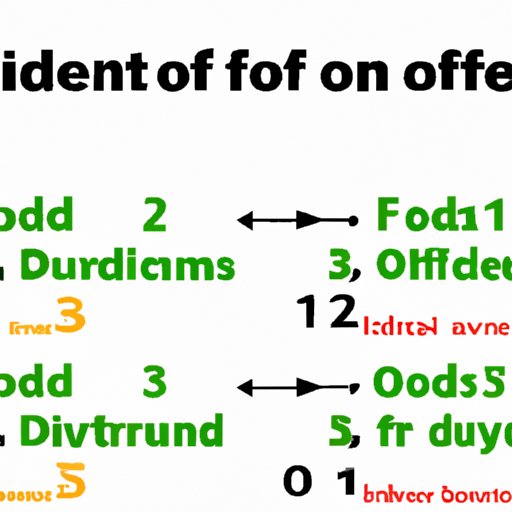
Introduction
Even and odd functions are commonly encountered in mathematics. These mathematical functions have unique properties that make them interesting and useful in various fields of study. Understanding whether a function is even or odd is important, as it helps solve many problems in mathematics, physics, engineering, and several other areas. This article will provide you with a comprehensive guide to determining whether a function is even or odd.

5 Simple Steps to Determine Whether a Function is Even or Odd
Before we dive into the details, let’s start with the most straightforward approach to determine whether a function is even or odd:
- Substitute -x for x in the given function.
- Simplify the function using algebraic properties.
- If the result is the same as the original function, then it is even. If the result is the negative of the original function, then it is odd. If neither is true, then the function is neither even nor odd.
Let’s apply these steps to an example:
f(x)=x2+3x+2
f(-x)= (-x)2+3(-x)+2 = x2-3x+2
Since f(-x) is not the negative of f(x), the given function is not odd.
Now, let’s try a different example:
g(x) = x3 – 2x
g(-x) = (-x)3 – 2(-x) = -x3 + 2x
Since g(-x) = -g(x), the given function is odd.
Keep in mind that some functions may not be even or odd. Also, do not forget to simplify the expressions carefully. Making small errors can result in incorrect answers.
Mastering Even and Odd Functions: A Guide for Beginners
The even and odd functions are essential concepts that can be quite challenging to grasp initially. However, understanding their fundamental properties can significantly assist in solving complex problems.
An even function is one that satisfies the condition:
f(-x)=f(x)
For any value of x that satisfies the function, substituting -x for x will result in the same value.
Examples of even functions include:
- f(x) = x2
- f(x) = |x|2
An odd function is one that satisfies the condition:
f(-x)=-f(x)
For any value of x that satisfies the function, substituting -x for x will result in the negative of the value.
Examples of odd functions include:
- f(x) = x3
- f(x) = |x|3
Cracking the Code: Identifying Even and Odd Functions with Ease
Determining whether a function is even or odd can be a time-consuming task. Fortunately, shortcuts exist that make identifying even/odd functions simpler.
Shortcut 1: If a function has only even powers (such as x2, x4, etc.), it is an even function. In contrast, if the function has only odd powers (such as x, x3, x5, etc.), it is an odd function.
Example:
f(x) = 3x6+ 4x2 -16
Since the function has only even powers, it is an even function.
Shortcut 2: If a function is divisible by x or x+1, then it is odd.
Example:
f(x) = x(x-1)(x+1)
The given function is divisible by both x and x+1. Therefore, it is an odd function.
While shortcuts can be useful, it’s important to note that they can also lead to incorrect answers if not used carefully.
Unravelling the Math Behind Even and Odd Functions
If you prefer a more algebraic approach to determining even/odd functions, this section is for you.
Let f(x) be any function, and let a be a constant. Then:
f(x) = f((x+a)/2) +f((x-a)/2)
This formula is known as the even/odd decomposition formula. If f(-x) = f(x), then the function is even.
If f(-x) = -f(x), the function is said to be odd.
The decomposition formula can help to simplify complex functions to their even and odd counterparts. It is commonly used in Fourier series and signal processing.
The Ultimate Cheat Sheet for Determining Even and Odd Functions
Now that you have learned all the different aspects of even and odd functions, we have compiled a cheat sheet as an easy reference for you. It contains all the necessary shortcuts and formulas that you need to determine whether a function is even or odd.

Math Hacks: How to Tell if a Function Is Even or Odd in Just Seconds
Here are three additional quick methods for determining even/odd functions that can help save time:
- To check if a function is even, remove x from the function and replace it with -x. If the simplified expression is the same as the original function, it is even.
- To check if a function is odd, remove x from the function and replace it with -x. If the simplified expression is the negative of the original function, it is odd.
- To check if a function is odd, differentiate it with respect to x. Then, multiply the result by -1 and compare it with the original function. If the new result is the same as the original function, it is odd.
Understanding Symmetry in Functions: Identifying Even and Odd Functions
Symmetry is an essential concept in mathematics. A function is said to be symmetric if it has a mirror image or reflection. Even and odd functions have specific types of symmetry.
An even function is symmetric around the y-axis, meaning that any point (x,y) on the graph has a corresponding point (-x, y) on the graph.
An odd function is symmetric about the origin, meaning that any point (x,y) on the graph has a corresponding point (-x, -y) on the graph.
Understanding symmetry in functions can help identify even/odd functions.
Conclusion
Determining whether a function is even or odd can be challenging, but with the right approach, it is a task that can easily be accomplished. We hope that this comprehensive guide has provided you with the necessary tools to solve even/odd function problems with confidence. Remember to apply the appropriate steps, test the function, and be mindful of common errors.





